Located in the Emilia-Romagna region of northern Italy, the Renaissance city of Ferrara makes for a delightful visit from Bologna, Venice, or Milan, especially if you enjoy history, culture, and good food. Read on to discover the best things to do in Ferrara, Italy!
With a wealth of art and architecture ensconced within medieval walls, Ferrara boasts beautiful palazzos and cobblestone streets that invite wandering.
And despite easy access from several large cities, Ferrara is pleasantly uncrowded (you’ll see more locals than tourists!) and retains a lot of its charming medieval atmosphere.
The Best Things to Do In Ferrara
Situated on the Po di Volano, a stream of the Po River, Ferrara became a prominent artistic and cultural hub in medieval times, under the rule of the House of Este.
The city, and its Po Delta, are designated a UNESCO World Heritage Site.

Some links on this page may be affiliate links. If you click an affiliate link and make a purchase, we may receive a small commission, at no extra cost to you. For more details, refer to our disclosure.
Like the Medicis of Florence and the Gonzaga family of Mantova, the Este rulers were prominent patrons of the arts.
During their rule, court architect Biaggio Rossetti conceived and executed the Erculean Addition to the city, based on Renaissance urban planning principles.
Many prominent artists of the time contributed to the decorations of the various palaces in the city.
Walking through Ferrara is like walking through history.
Although there are a number of attractions in Ferrara you must definitely visit, allow for time to just wander the streets and soak up the medieval charm. It’s a memory that will live with you for a long time.
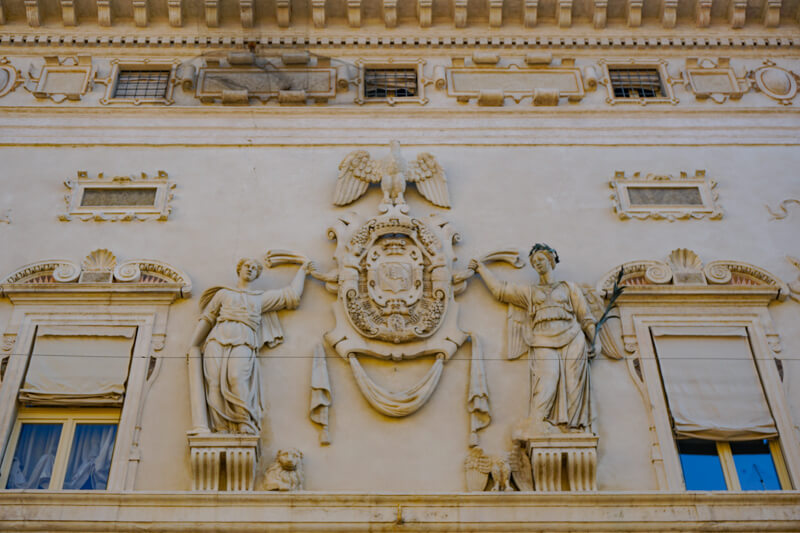
Let’s dive in and discover the best things to do in Ferrara, shall we?
#1 Tour the Castello Estense
Touring Ferrara’s top attraction, the Castello Estense, should be at the top of your itinerary for the city. Also known as Saint Michael’s Castle, the medieval stronghold was built to protect the ruling Este family in the event of riots.
With a moat, three drawbridges, and four massive towers, the red brick castle dominates the historical center of Ferrara.
Although the interior of the castle has been remodeled many times, the exterior still looks the same as it did when it was completed in the 16th century.
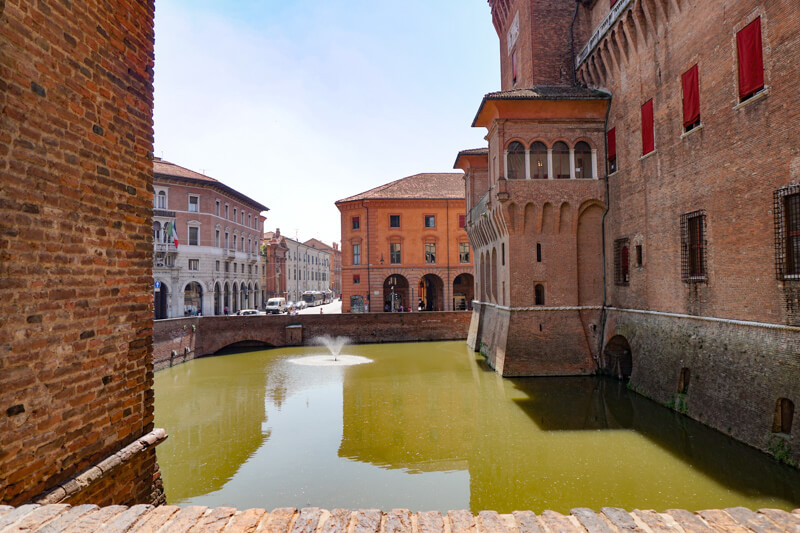
At the bottom level of the castle, you may be able to visit the dungeons. Two of the cells once held the unlucky young lovers Ugo and Parisina.
Parisina, the young second wife of Marquis Niccolò III, fell in love with her stepson Ugo, and he with her. They were found out, imprisoned in the dungeons, and eventually beheaded.
Inside the main castle, you’ll see many rooms with beautiful ceilings, some ornately frescoed. In particular, the ceilings with paintings depicting different games and sports are marvelous.
Sadly, some of the ceilings were damaged by earthquakes, and cracks have been taped over.
One cool thing we loved was the placement of angled mirrors in some rooms to make it easy to view the ceiling frescoes without having to stay with your neck craned upwards.
Most rooms are devoid of furnishings, but the frescoes and detail on the ceilings keep you riveted as you walk through the castle.
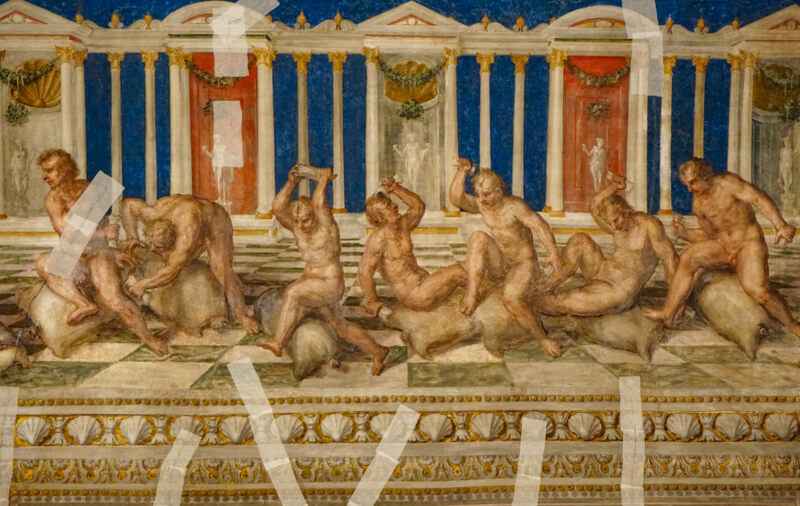
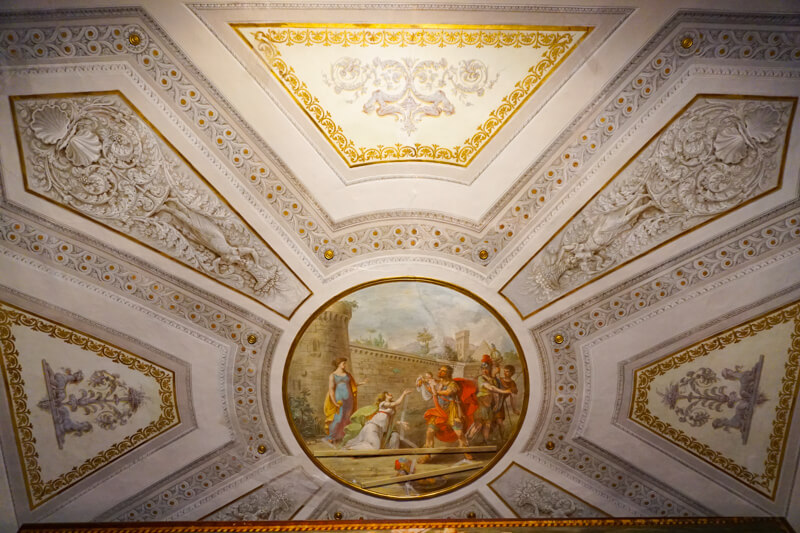
Visit the Courtyard of the Oranges, take in the beauty of the Ducal Chapel, and enjoy the panoramic views from the tower.
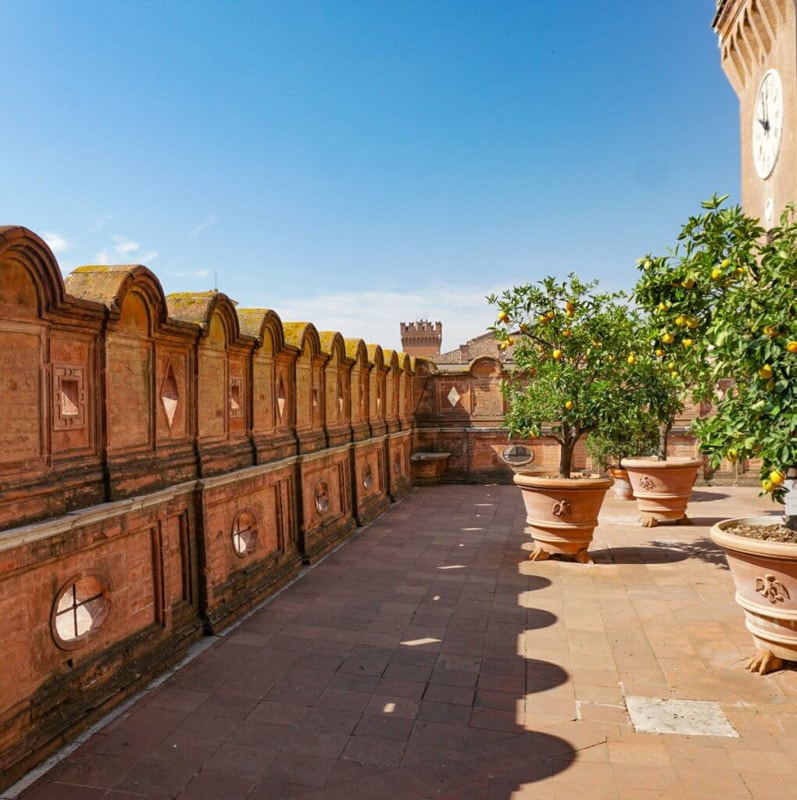
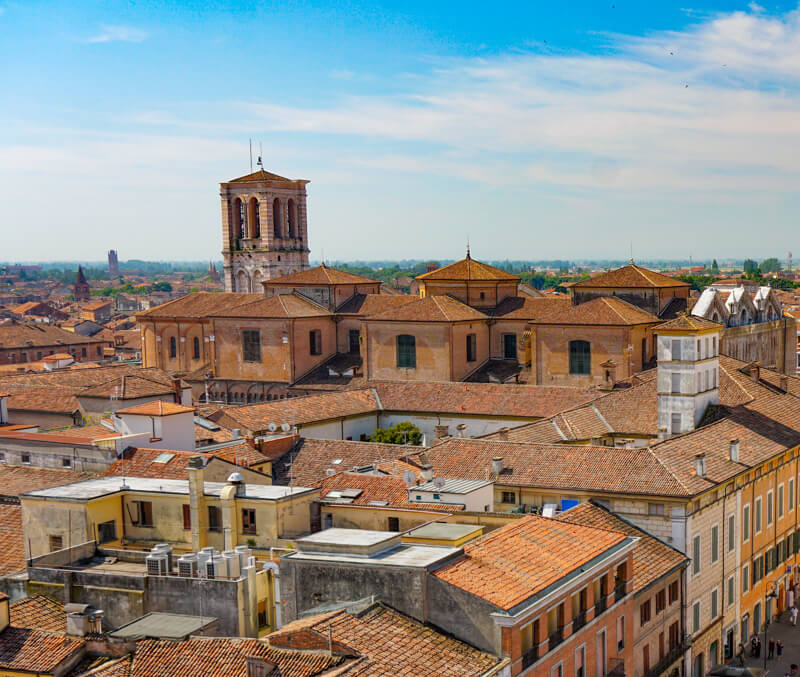
The castle is closed on Tuesdays. For current operating hours and admission prices, visit the castle website.
#2 Visit the Cathedral of Saint George
The Duomo di Ferrara, officially the Basilica Cattedrale di San Giorgio, is located in the historic center, not too far from the Este Castle. The Renaissance bell tower, left unfinished, looks stunning in white and pink marble.
Built in the 12th century, the cathedral features a stunning Romanesque facade in white marble, with three cusps.
On the ornate facade, you’ll see several statues and bas reliefs. The facade was sadly under restoration when we visited in 2019, so we couldn’t see it.
Note: As of May 2023, the cathedral is still being restored. A part of the facade is now visible, and there may be limited access to the interior.
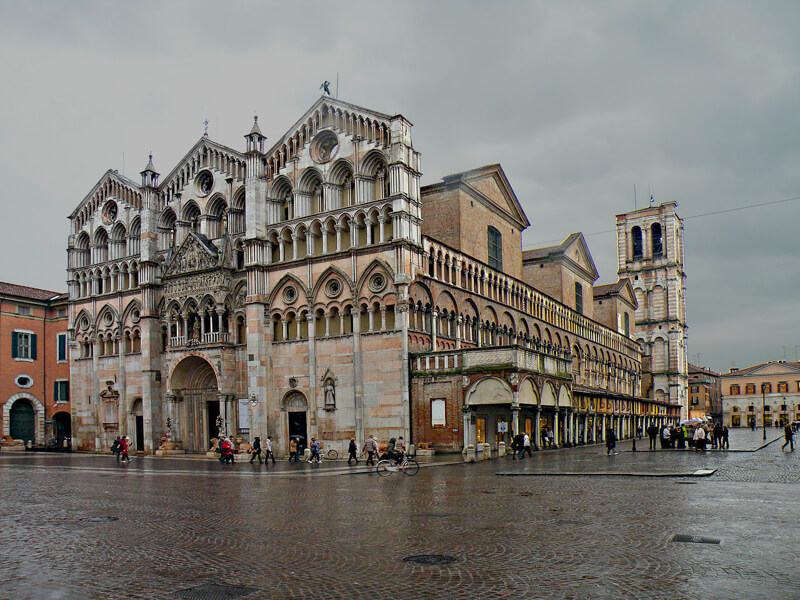
The Baroque interior features an ornate ceiling and several works of art. And across the square is the Cathedral Museum, where you can view more masterpieces. The museum is housed in the former Church of San Romano.
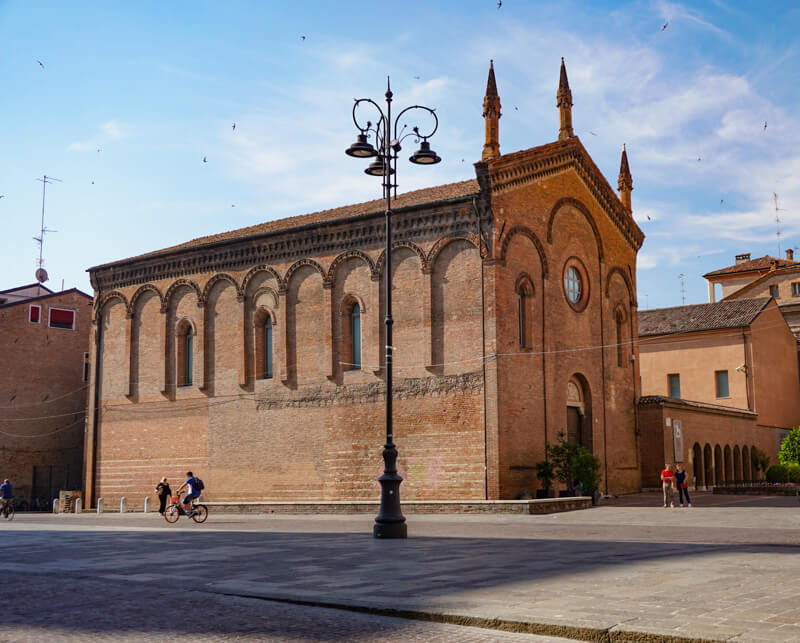
#3 Stroll the Piazza del Municipio
The Piazza del Municipio, just next to the Duomo, is the courtyard of the old Palazzo Ducale in Ferrara. Lined with stunning buildings, the piazza is a must-visit in Ferrara.
Enter through the imposing archway flanked by two statues of members of the Este family, Nicolò III and Borso D’Este.
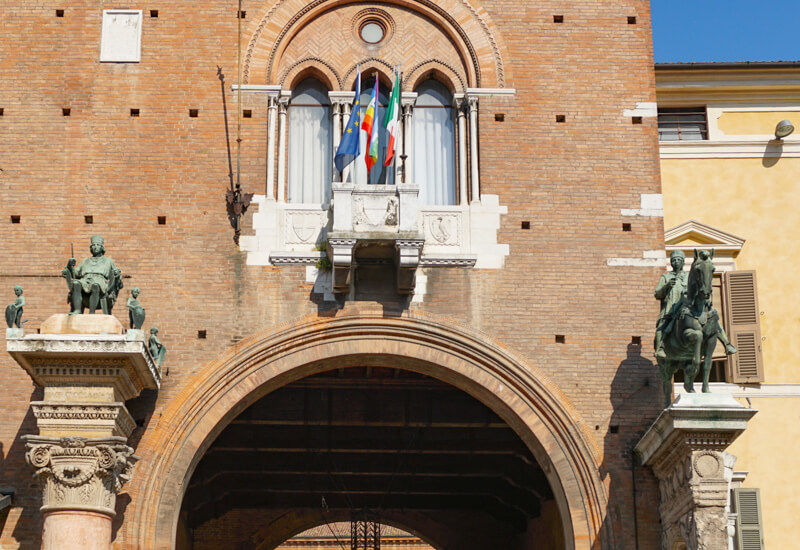
Admire the 15th-century Scalone d’Onore, a Renaissance staircase made of marble. Gawk at the marble-embellished windows of the old ducal residence. Look for the fascinating sundial calendar.
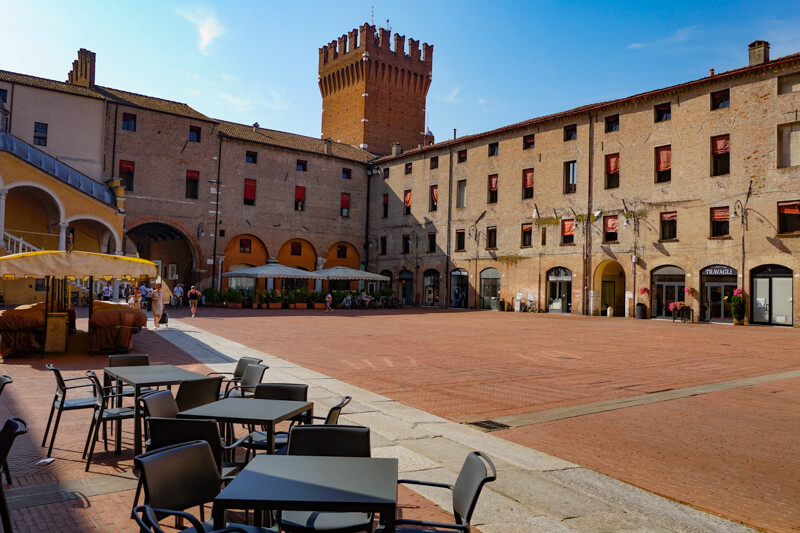
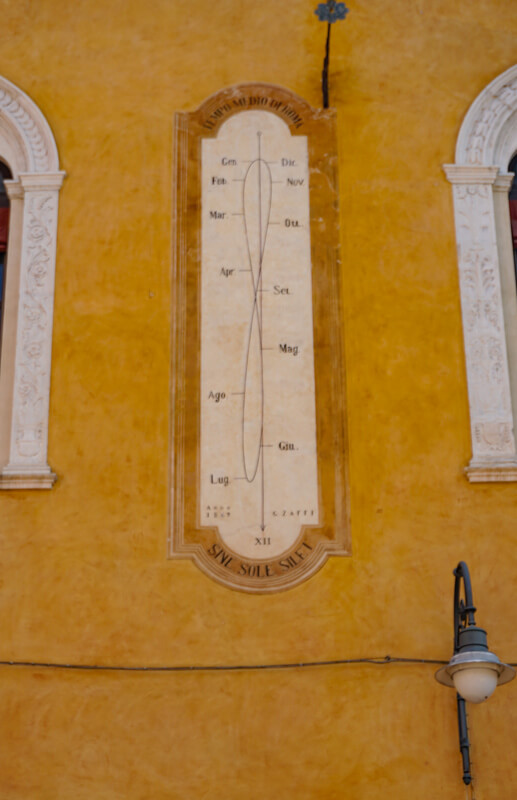
#4 Walk the Piazza Trento e Trieste
The long Piazza Trento e Trieste is a fascinating place to stroll, people watch, and take photos. Along its periphery, you’ll find cafes and restaurants, perfect for a rest and a drink as you enjoy all the action around you.
On one side, the piazza features the loggia dei Merciai, which runs along the side of the Duomo di Ferrara. Beyond is the unfinished bell tower. A commercial hub during medieval times, the loggia continues to house a number of shops today.
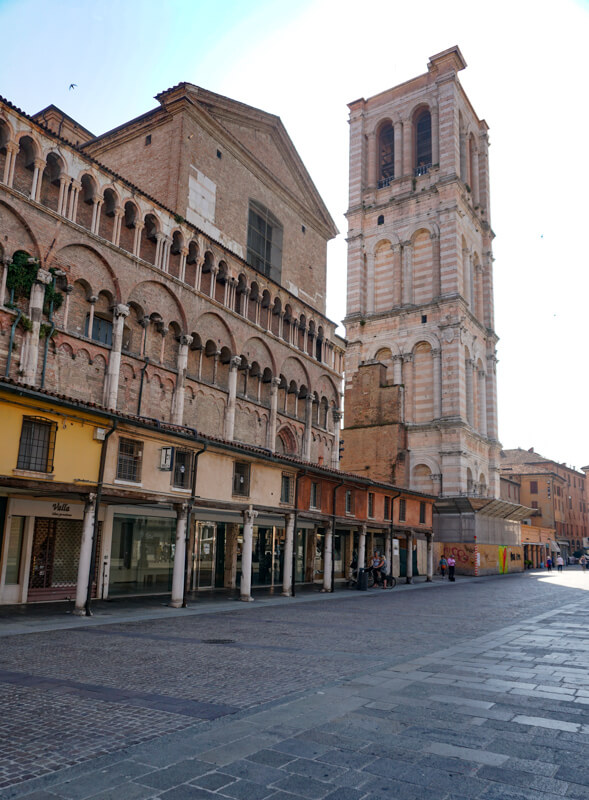
The piazza features many other buildings of note along its other sides, including the Bishops’ Palace, the Town Hall, and the Palazzo della Ragione, which was rebuilt after a fire.
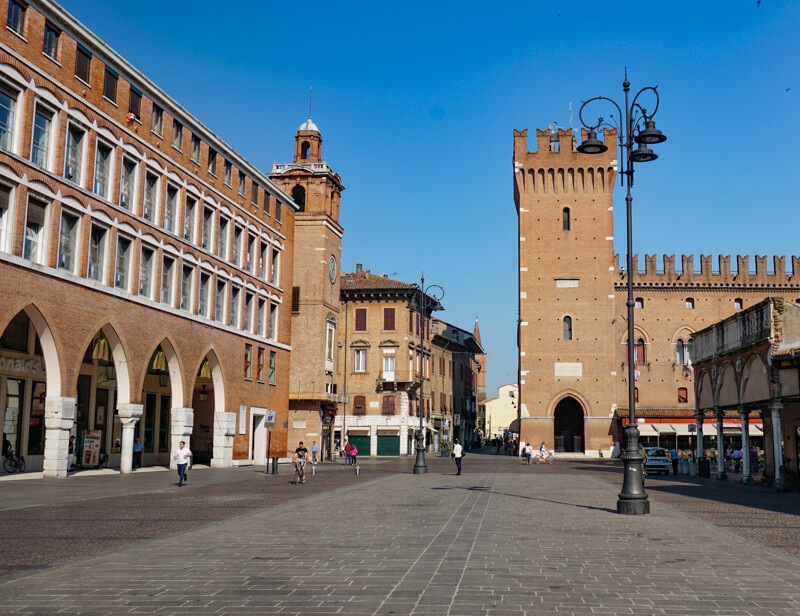
Markets are held in this piazza on some days of the week, and if you are lucky enough to visit on one of those days, join the locals as they browse the stalls!
#5 Snap a photo of the Torre dell’Orologio
At one end of the Piazza Trente e Trieste you’ll find Ferrara’s graceful clock tower, built in the 15th century. While not as interesting as the clock tower in Mantua, for example, it is still worth a quick stop for a photo.
And if you like chocolate, pop into the little shop at the bottom of the tower for some sweet treats!
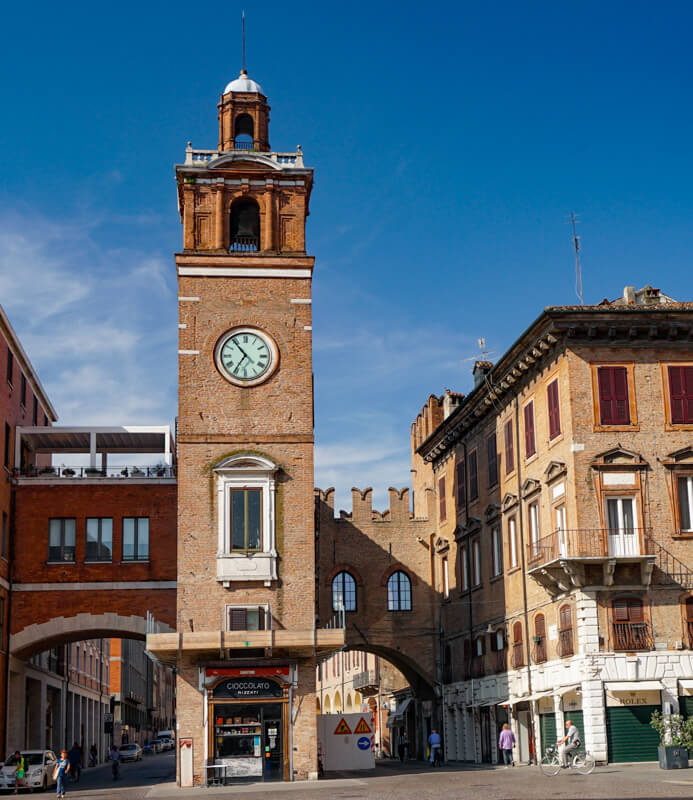
Ferrara has other clock towers you can photograph. One of the most striking we came across is the clock tower at the Palazzo Paradiso. The building is beautiful as well!
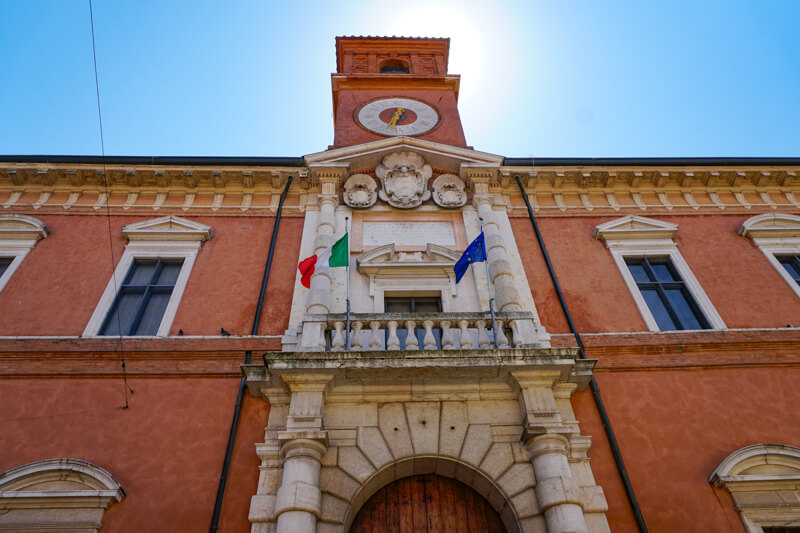
#6 View the art at Palazzo Schifanoia
The Palazzo Schifanoia, on Via Scandiana, is known for its gorgeous frescoes. A Renaissanace palace built for the ruling Este family, Palazzo Schifanoia is a must-visit in Ferrara if you enjoy medieval art.
While the facade as it exists now is rather plain, the main entrance to the palazzo, in white marble, is lovely. The coat of arms of the House of Este is displayed above the door.
In the Salone dei Mesi, admire Cosimo Tura’s allegorical depiction of the months of the year, with gods in chariots drawn by beasts, along with scenes appropriate to each month.
The detail and the colors are stunning, but sadly, time and weather have damaged several of the frescoes.

In the Sala delle Virtù (Hall of Virtues), gaze up in awe at the painted ceiling, split into compartments. Finish your visit with a break for coffee and a pastry in the cafe, located at the back of the palace in the garden.
#7 Discover the medieval Casa Romei
Another palazzo in Ferrara you must visit is the Casa Romei, which belonged to Giovanni Romei. Romei married into the Este family and became an important administrator to the family.
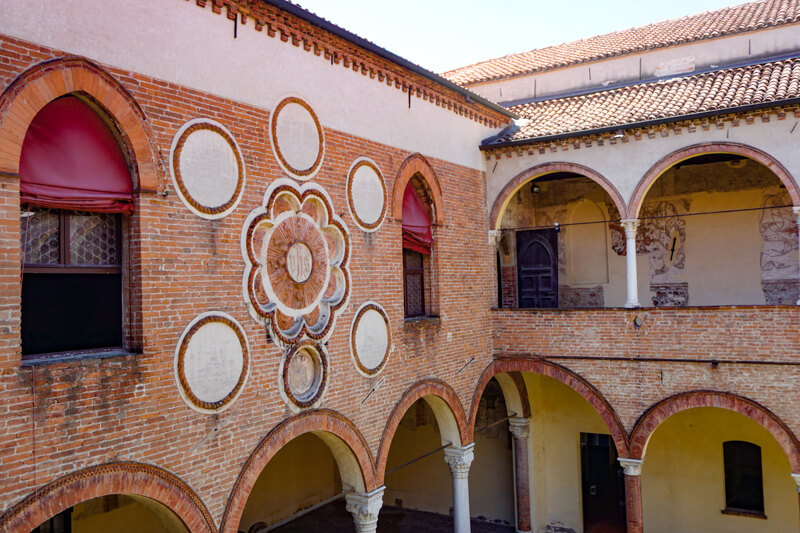
The 15th century palazzo is built around a cloistered courtyard with an old well. The rooms of the palazzo, and the passageways, feature the remnants of beautiful frescoes.
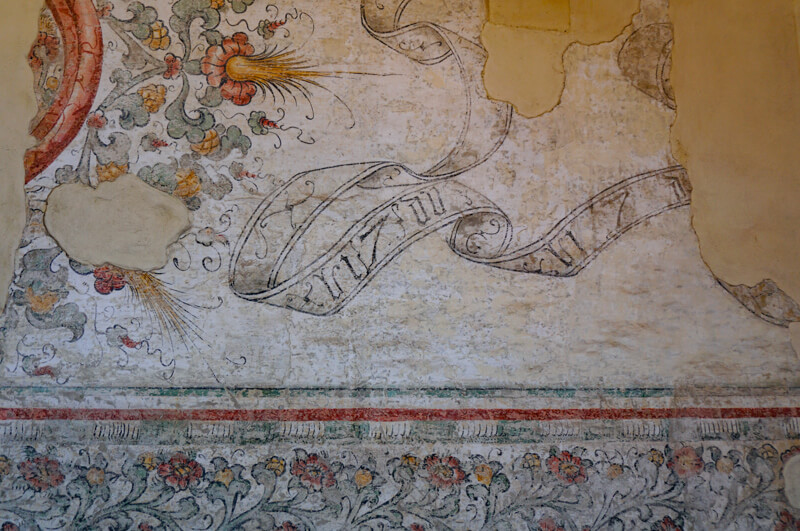
Today the palazzo houses a museum of sculptures and frescoes rescued from former churches, convents, and civic buildings. The works of art make for interesting browsing, and the building itself is a serene oasis.
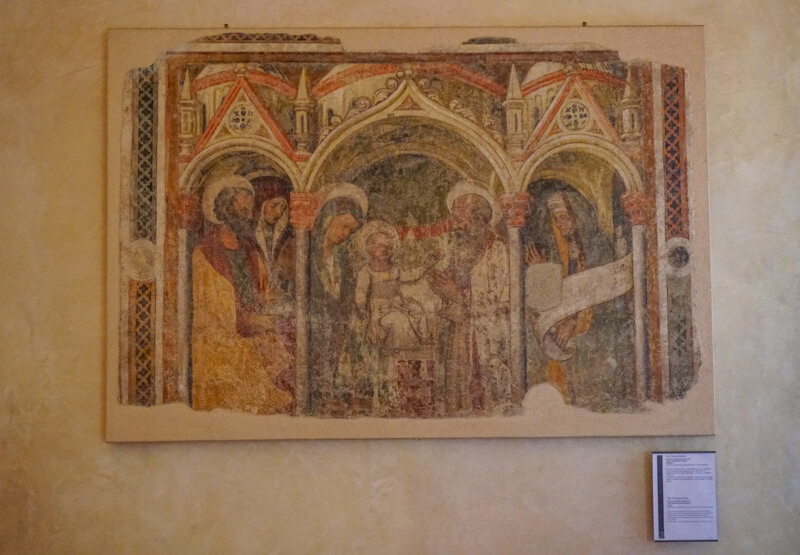
#8 Marvel at the facade of the Palazzo dei Diamanti…
The Corso Ercole I d’Este is a beautiful street just across the road from the Castello Estense. One of the two main streets of the Erculean Addition, Corso Ercole I d’Este features beautiful Renaissance palaces on both sides.
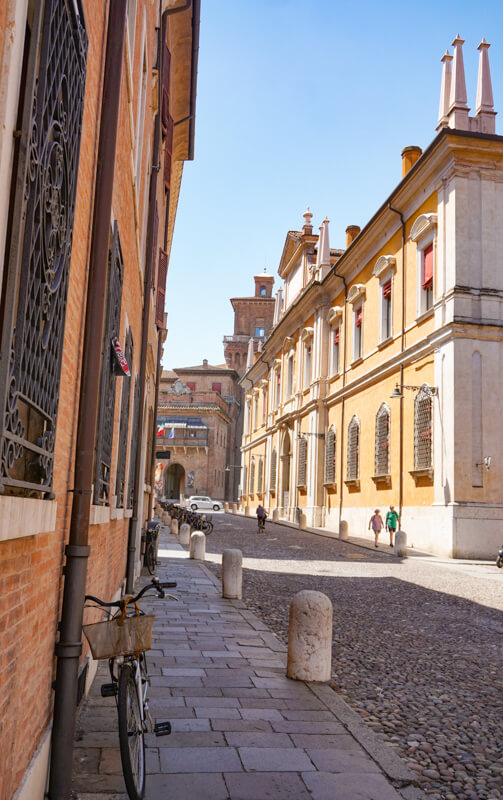
The Erculean Addition came about when towards the end of the 15th century, Duke Ercole I d’Este asked court architect Biagio Rossetti to tear down the walls of Ferrara on the north and build an addition to the city, to accommodate Ferrara’s growing population.
Although several of the palazzos that line the Corso Ercole I d’Este have richly decorated facades, none is as beautiful as that of the Palazzo dei Diamante, designed by Rossetti for Sigismonde d’Este, brother of the Duke of Ferrara.
The exterior of the palace is made up of more than 8,000 white-laced-with-pink marble blocks, carved in the shape of diamonds. Hence the name, the Palace of Diamonds.

Designed to reflect light beautifully, just like the facets of diamonds, the facade of the Palazzo dei Diamanti is one of the most unique and beautiful I have ever seen!
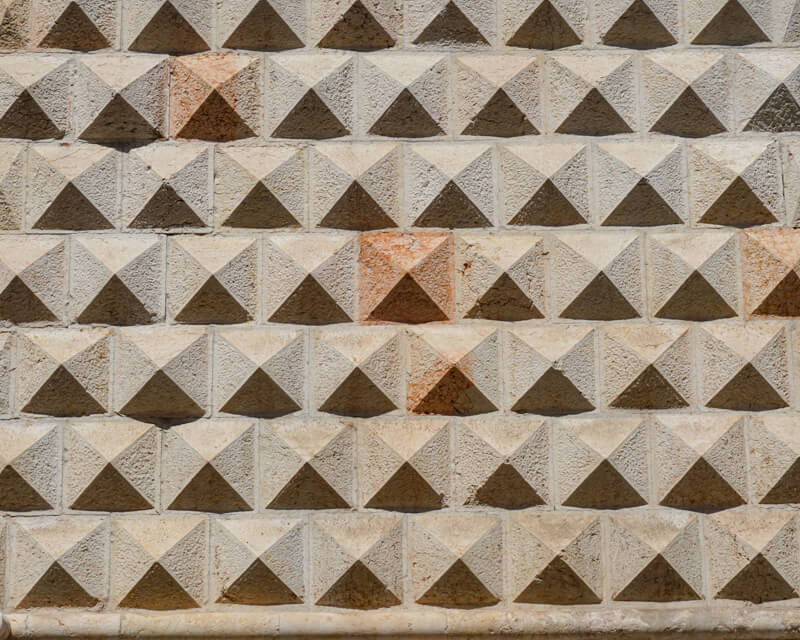
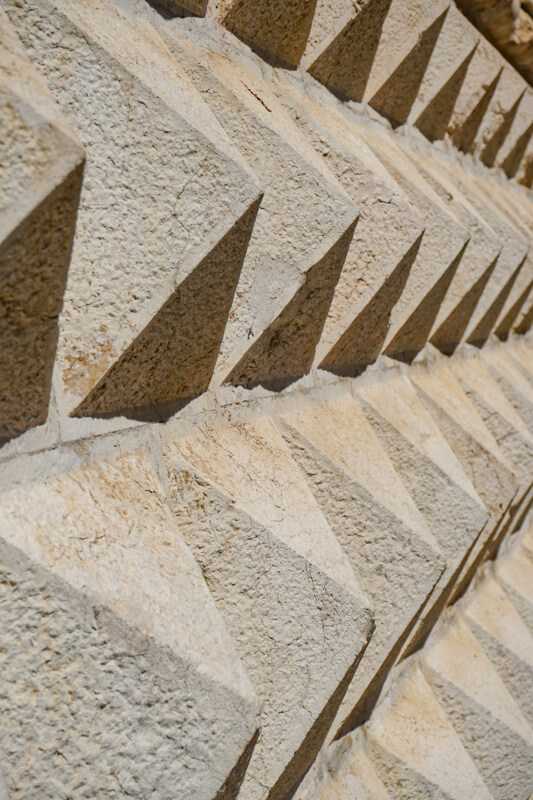
#9 …And tour the National Gallery of Art inside
The first floor of the Palazzo dei Diamante houses the Pinacoteca Nazionale di Ferrara (the National Art Gallery of Ferrara). The collection is largely composed of works from the Ferrara school, from the Middle Ages until the 18th century.
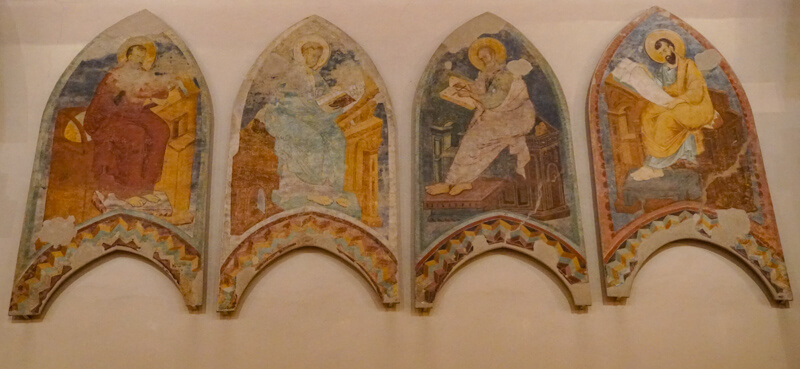
Among well-known artists featured in the collection are Cosmè Tura, Garofalo, Jacopo Bellini, Andrea Mantegna, Nicola Pisano, and Tintoretto.
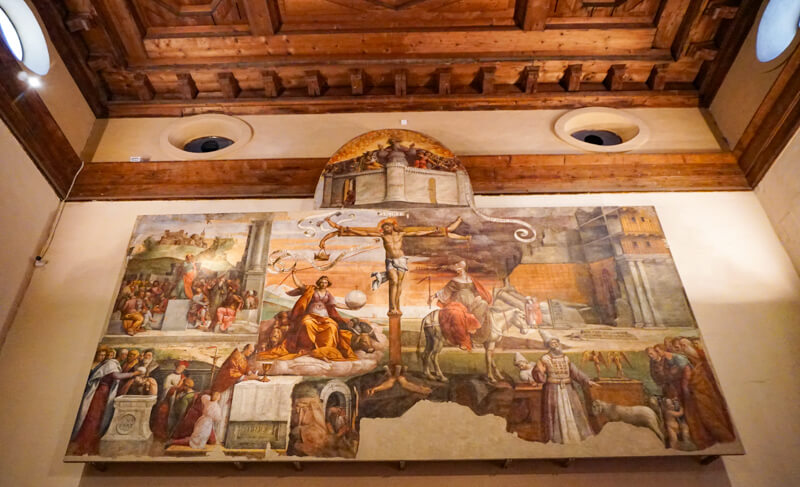
The lower floor of the palace houses the Civic Gallery of Modern and Contemporary Art, which hosts temporary exhibitions featuring great international masters. Check to see if there is one happening when you plan to visit!
#10 Peek into the Museum of the Risorgimento
Housed in another one of the palaces along the same street is the Museo del Risorgimento e della Resistenza, worth visiting if you enjoy history. If not, or if you are short on time, peek inside the pretty courtyard, dressed up in flowers in season.
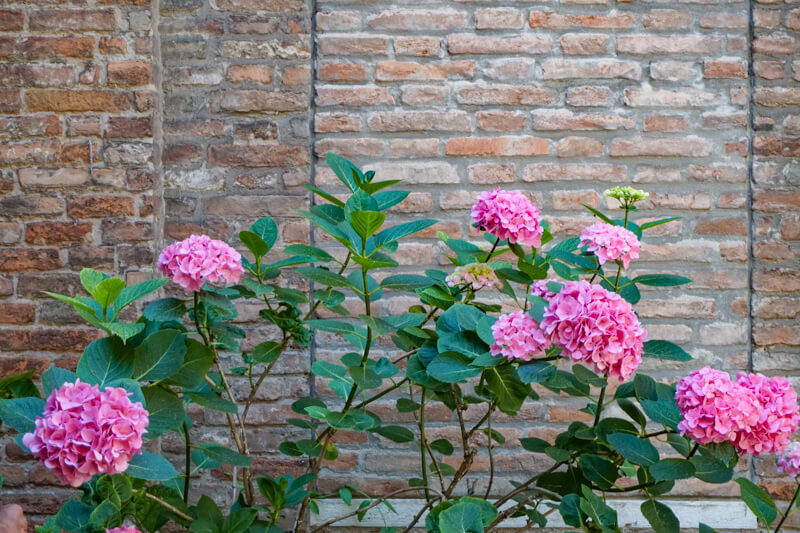
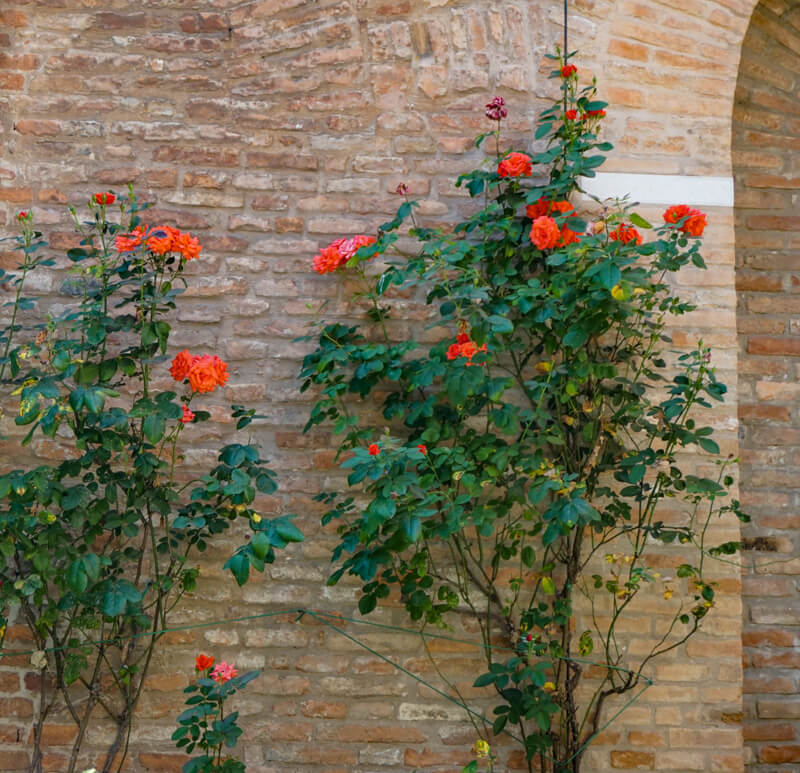
With lots of documents, posters, and clippings, the exhibits here take you through the history of the reunification of Italy in the 1800s. Much of the material is in Italian, but you can still enjoy the display of uniforms and mementos.
#11 Wander the Jewish Quarter
The Jewish community was an integral part of the fabric of Ferrara during the rule of the Este family, and many prominent Jewish people lived on the Corso della Giudecca, a large street connecting medieval and Renaissance Ferrara. The city was a prominent center for Jewish printing.
But after the Este family’s rule ended at the end of the 16th century and the Pope took control of Ferrara, the situation changed and the Jewish community was confined to the ghetto, in the area around Via Mazzini.
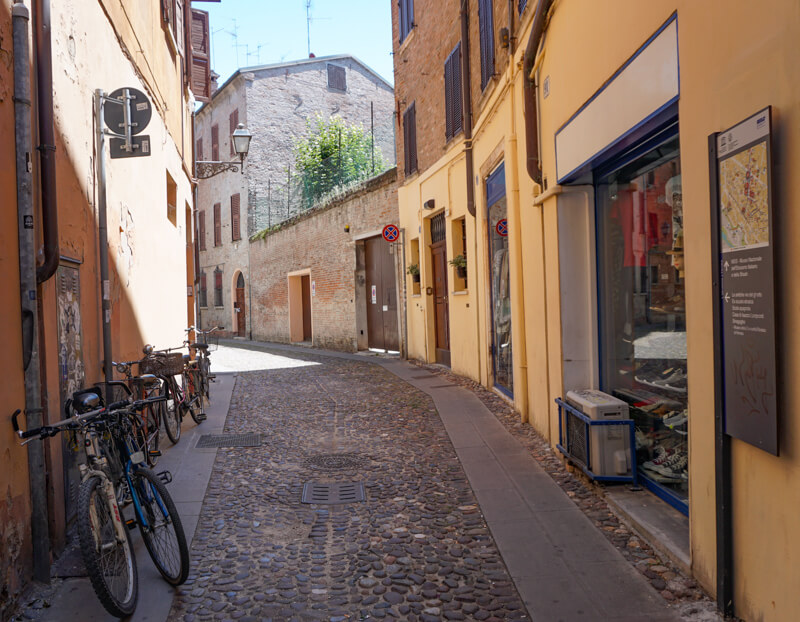
The synagogue on Via Mazzini houses the Jewish Museum, and you can wander the medieval streets of the ghetto, which have been preserved as they were, except for the renovation of individual buildings.
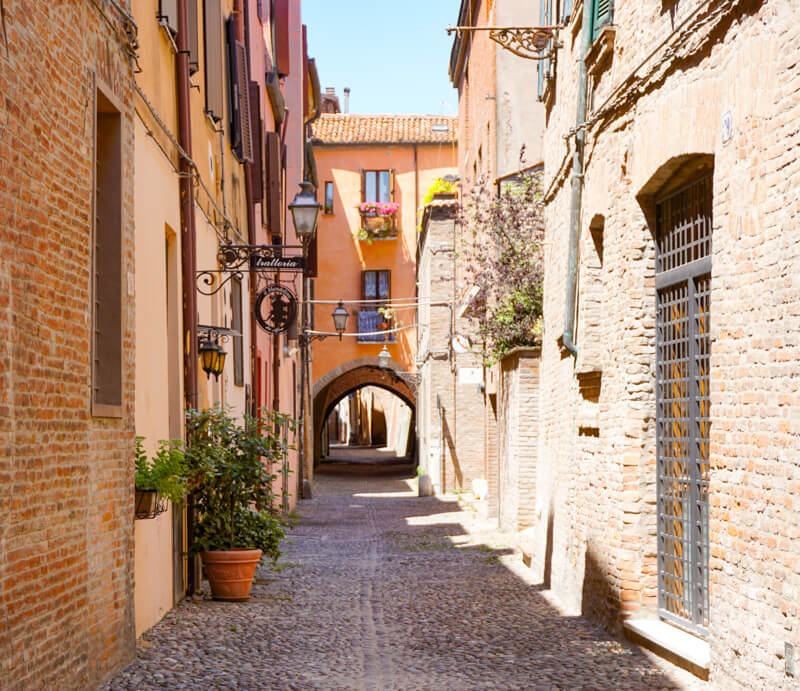
If you enjoy learning as you walk, join a guided 2-hour walking tour of the city that takes you past most of the major sights in Ferrara.
#12 Tour a church…or two
Other than the Duomo, Ferrara boasts a number of beautiful churches. On a one day visit, you will likely just have the time to step into one or two of them as you walk around the historic center.
The Chiesa di San Francesco lies on the way to the Casa Romei. Redesigned in a Renaissance style by Rossetti at the time of the Erculean addition, the church was damaged in the Ferrara earthquake of 2012 and is being restored at the time of writing. But you can still go in and view the art work.
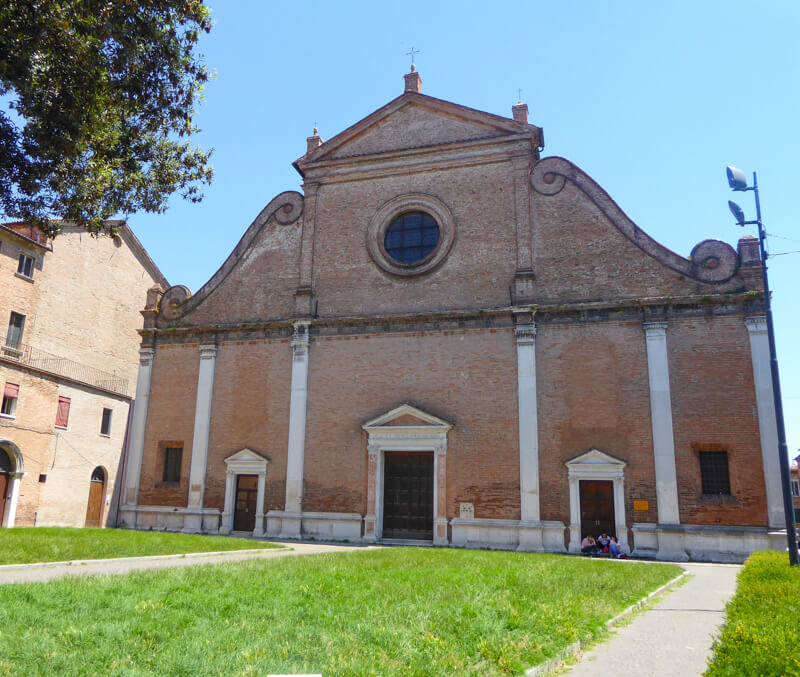
You’ll find the Chiesa di Santa Maria in Vado near the Palazzo Schifanoia. Also redesigned by Rossetti towards the end of the 15th century, the church is famous because blood is supposed to have appeared from the host during consecration on Easter in the year 1171.
#13 Stop by the Rotonda Foschini
We stumbled upon La Rotonda Foschini by accident towards the end of our day in Ferrara, and I was so glad we did! The beautiful courtyard is a part of the Teatro Communale of Ferrara.
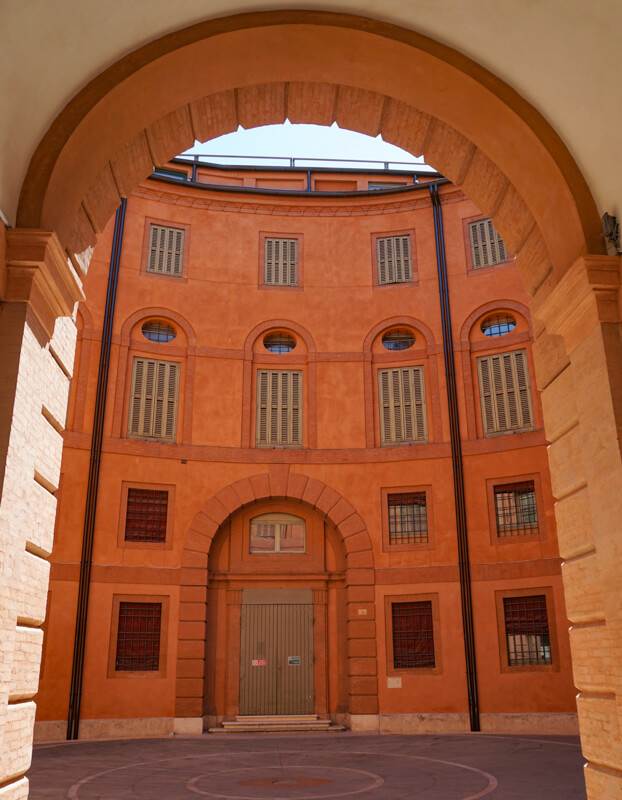
The elliptical shaped rotonda is beloved by photographers, and no wonder. Point your camera up and take a shot of the top opening of the courtyard with the sky above, for a great photo.
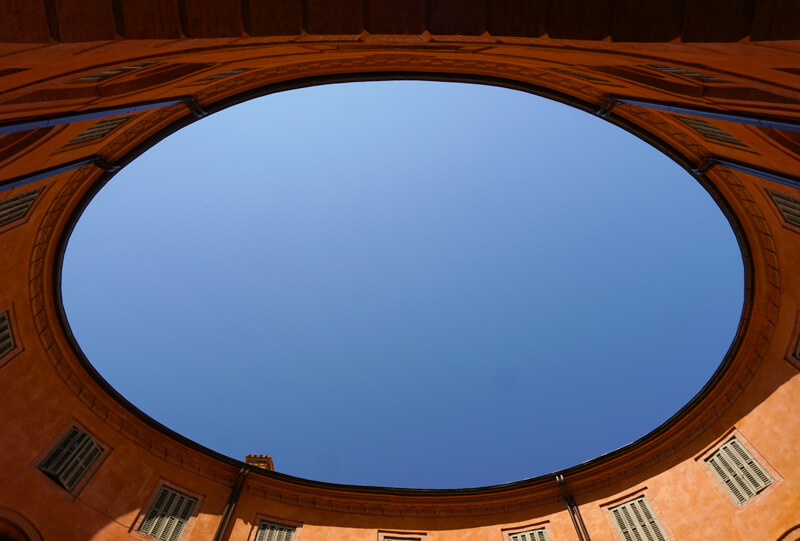
The theater was completed towards the end of the 18th century, after construction was stalled for many years due to disagreements between Antonio Foschini and Cosimo Morelli, the two architects hired for the project.
#14 Walk the city walls
The walls of Lucca in Tuscany are probably Italy’s most renowned, but Ferrara’s walls are almost as worthy of a walk. Stretching for about 5.5 miles around the historic center, the walls can be accessed from the Corso Ercole I d’Este.

Walk or bike the walls, following the route along the embankment or along the moat just inside. With lots of green spaces and trees, the walkways are mostly paved, and you can spend whatever amount of time your itinerary allows.
#15 Gorge on gelato at Gelateria La Romana
Having done our gelato homework ahead of our visit, we made our way to Gelateria La Romana for our sweet treat.
Aside from lots of flavors of gelato artigianale, the shop also sells pastries and cakes. It was difficult to choose just one treat each!
We sampled four flavors of gelato between the two of us, and every single one was delicious. Creamy texture, not cloyingly sweet, and bursting with flavor. Well worth the walk from the historic center!
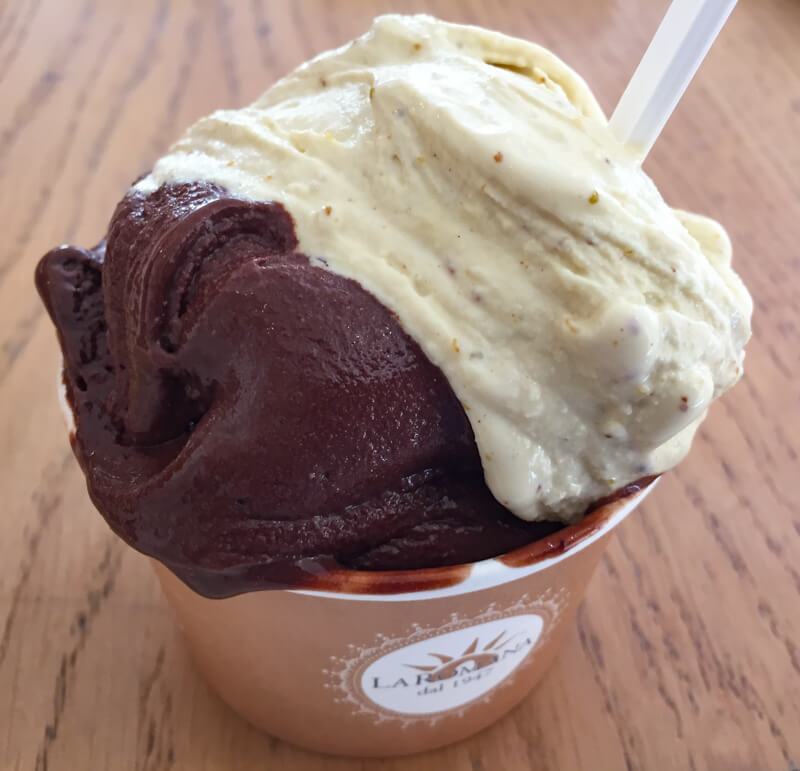
#16 Try capellacci di zucca
When in Ferrara, make sure you try the signature pasta dish of the city; capellacci di zucca. Made fresh by hand, the hat-shaped pasta are stuffed with cooked butternut squash or pumpkin, grated parmesan, and nutmeg.
Generally served in a sauce made with melted butter and fresh sage, capellacci di zucca can also be enjoyed with a tomato-based sauce or a meat sauce.
We also shared a plate of gnocchi. The pasta was filling enough that we complemented it only with some grilled vegetables for a satisfying lunch.
For meat lovers, salama da sugo (pork sausage) is a must-try!
Also try the coppia Ferrarese, the local bread that’s made with two pieces of dough knotted together in the shape of a cross. If you are a vegetarian, be warned: the traditional recipe includes lard.
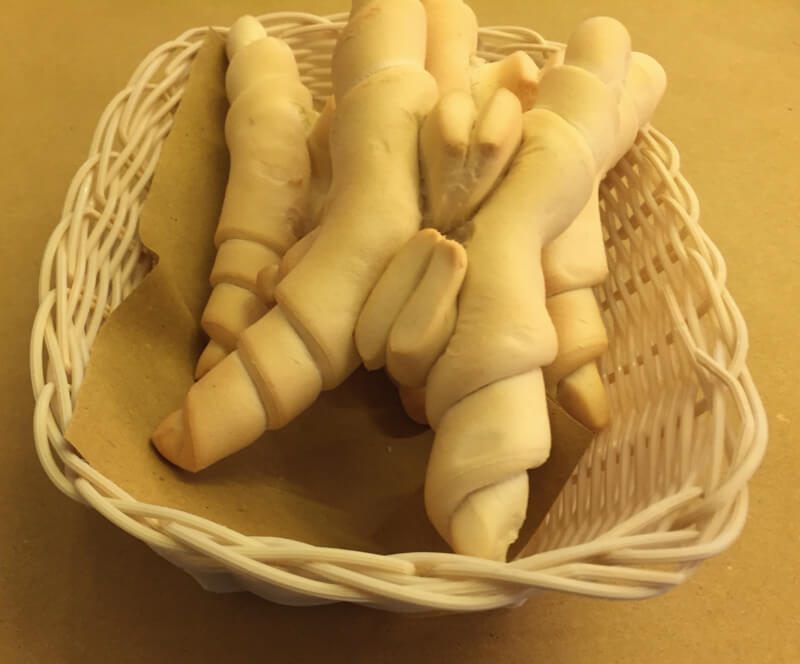
Getting to Ferrara
Ferrara is located in the Emilia-Romagna region of northern Italy and you can drive or take the train to arrive in the city.
Ferrara makes for an easy and wonderful day trip from Bologna or Venice, or even Verona, so plan to add it to your itinerary for northern Italy!
Drive
Here are the driving distances (and drive times, in normal traffic) from major nearby cities to Ferrara:
Bologna to Ferrara: About 30 miles, 50 minutes
Verona to Ferrara: About 58 miles, 1 hour 30 minutes
Venice to Ferrara: About 70 miles, 1 hour 30 minutes
Looking to rent a car for your Europe trip? Discover Cars offers you the ability to compare availability and prices across many major car-hire companies. Pick the car that best meets your needs!
Check availability and book your rental car now!
By Train
To travel from Bologna to Ferrara by train, it takes about 55 minutes (some trains are faster).
We visited Ferrara as a day trip from Bologna and I thought it was one of the best day trips from Bologna you can do. Leave early to maximize your time in Ferrara.
You can travel from Verona to Ferrara by train in about 1 hour and 40 minutes, with a change in Padova, and from Venezia Mestre to Ferrara in about 1 hour and 15 minutes.
You can walk from the train station in Ferrara to the Este Castle in about 20 minutes, or you can take a taxi or the local bus. Or rent a bike at the station!
To book bus and train tickets for Europe, consider Omio. I found the booking experience easy and hassle-free. They do charge a nominal service fee but I thought it was well worth the convenience! Plan out your itinerary and book all your tickets at once and you’ll pay the fee just once.
Getting around in Ferrara
You can walk everywhere in the historic center, but if you do most of the things I have described above, know that you will rack up the steps.
Or you can get around on bikes. Ferrara is a bike-friendly city, and you’ll see both locals and visitors zipping around the historic center on bikes. If you are a pedestrian, you have to watch for bicyclists.
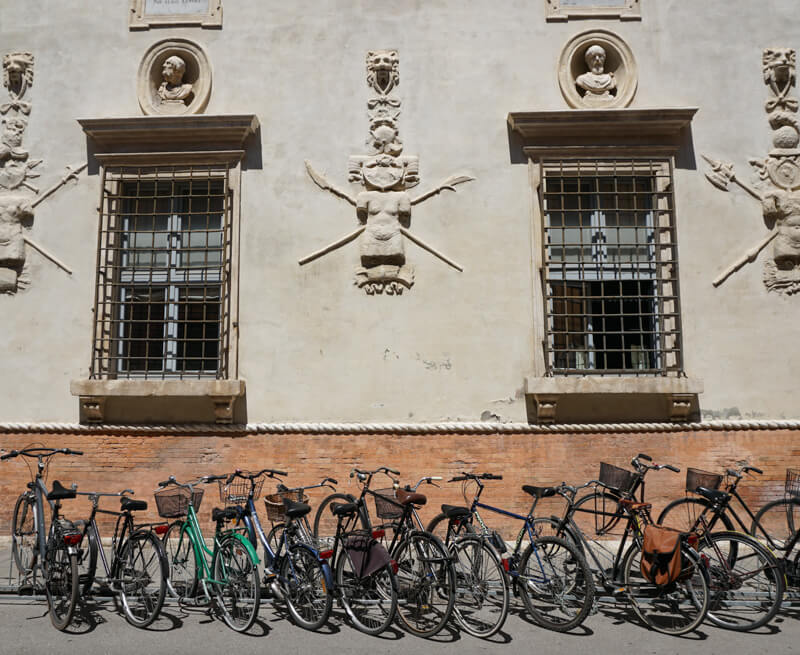
Where to stay in Ferrara
While you can visit Ferrara on a day trip, there are so many fabulous things to see and do in this lovely city that staying one or two nights would be ideal if you have the luxury of time.
Hotel Annunziata is located in the heart of the city center, just steps from the Castello Estense: in fact, some rooms have views of the castle! The hotel offers bike rentals, and the buffet breakfast is extensive. Rooms are spacious and air-conditioned, with comfortable contemporary furnishings.
Book a stay here!
The best time to visit Ferrara
From a weather perspective, any time between May and September is a great time to visit Ferrara. High temperatures are in the 70s in May and September and get into the mid-80s in July and August. Winters are very cold and not conducive to wandering around outside.
Ferrara is not on the main tourist trail and doesn’t get oppressively crowded even in the summer.
We visited in late June and had great weather with bright sunshine, and no crowds anywhere. We did run into some school excursion groups at the castle, but hung back until they were well ahead of us.
*****
So there you have it: my suggestions for fun things to do in Ferrara, Italy! Have you been? I would love to read your thoughts if you have: comment below to respond.
If you haven’t yet visited this beautiful city, now is the time to start thinking about a visit!
And if you are planning an Italy trip, read all my other articles in my Italy destination guide, from the perfect 3-week Italy itinerary for your first visit, to the best things to do in major cities like Florence and Rome.
If you plan to explore more in Emilia-Romagna, check out our guides to Modena, home to great food and fast cars, or Ravenna, where you’ll find the best mosaics in the west!
More Fun Places to Visit in Northern Italy
Venice: The Perfect 2-Day Venice Itinerary
Verona: The Best Things to Do in Verona
Ravenna: See the Best of the Ravenna Mosaics in One Day
Mantua: How to Spend One Amazing Day in Mantua
Modena: The Best Things to Do in Modena, Italy
Vicenza: The Best Things to Do in Vicenza
Bologna: The Best Things to Do in Bologna
Padua: One Perfect Day in Padua
Murano: What to See and Do on the Glass Island of Murano
Cinque Terre: Two Magical Days in the Cinque Terre
Did you find this article informative? Pin it for later reference!
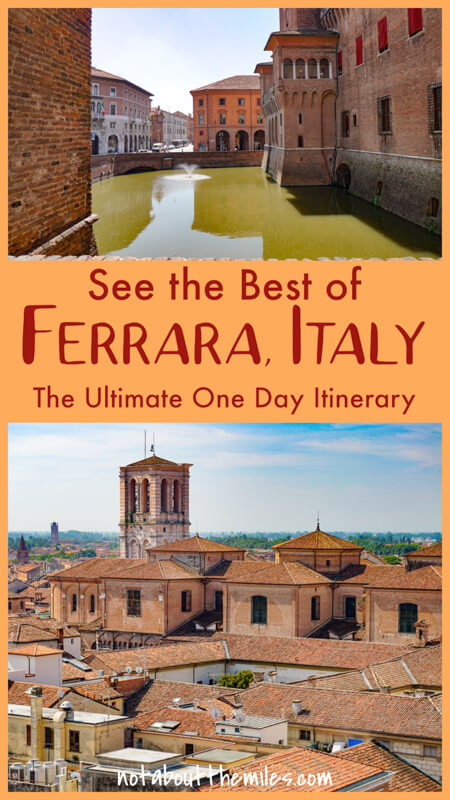
Photo License: Ferrara Cathedral CC BY-SA 3.0

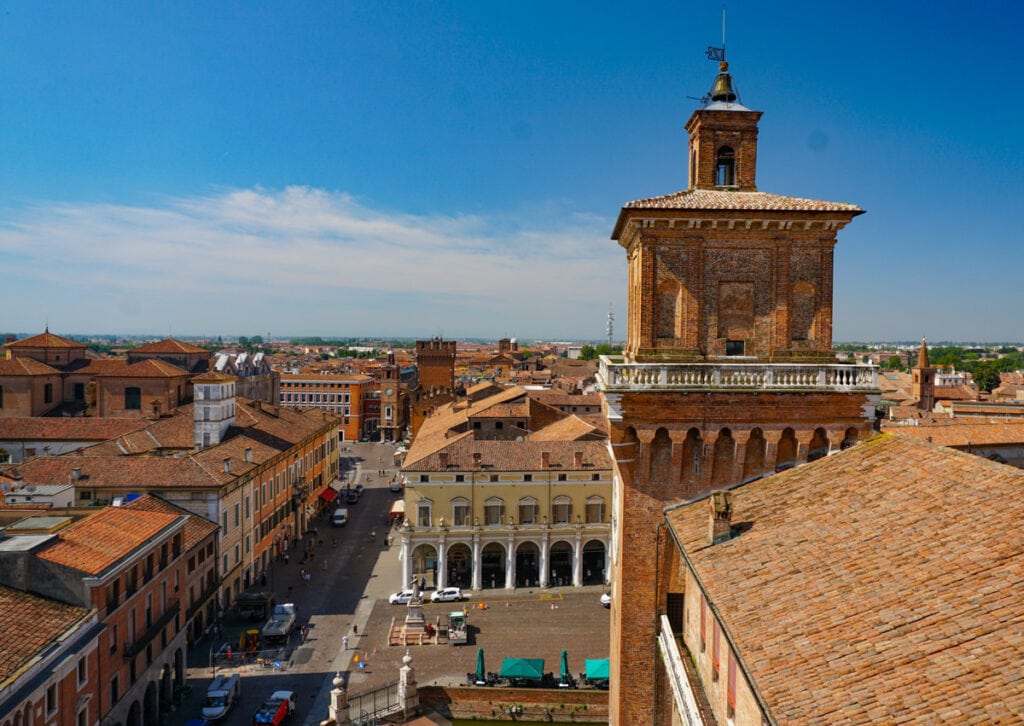
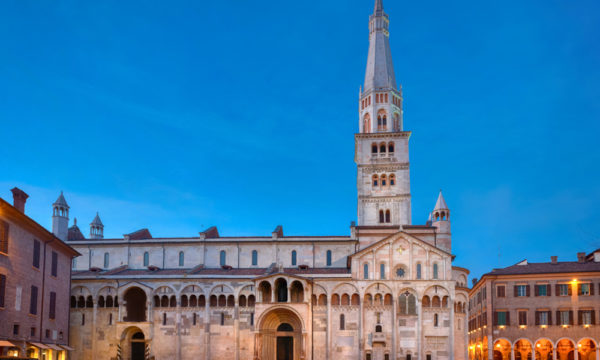
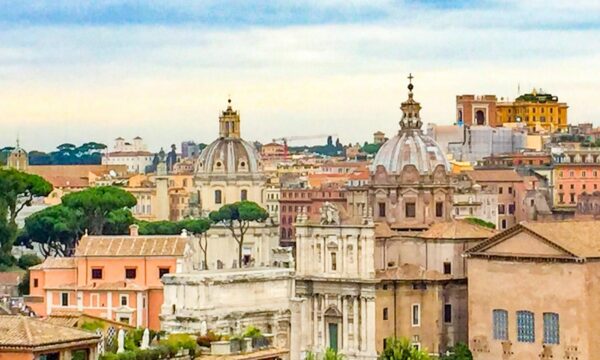

Thanks so much for this post! It seems that Ferrara has so many hidden gems to explore. It’s in-depth posts like these that make me want to visit certain places!
We are going to visit Venice and the surrounding area in April, and Ferrara is one of our stops. Your post is really helpful.
So glad you found the information useful! Enjoy your visit. Venice and Ferrara are both wonderful destinations!
The castle is actually closed on Tuesdays not Mondays.
Thanks so much for letting me know about the change. I have corrected.